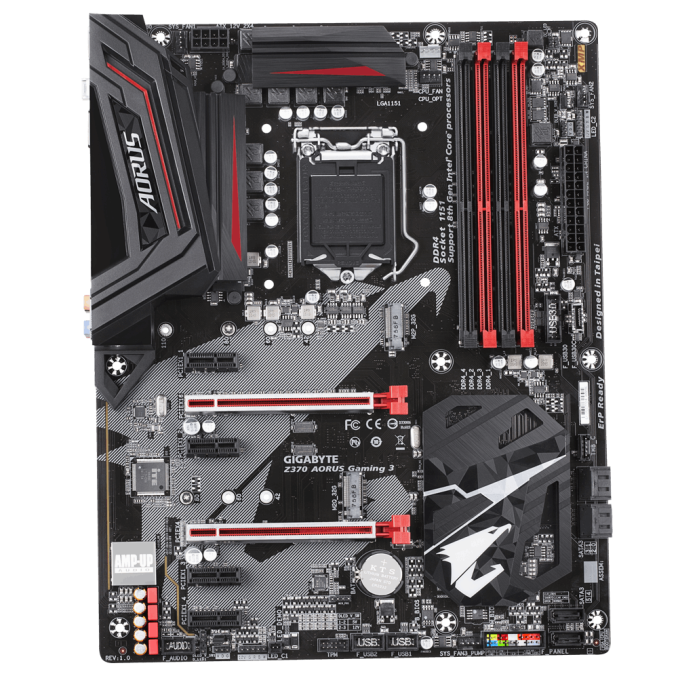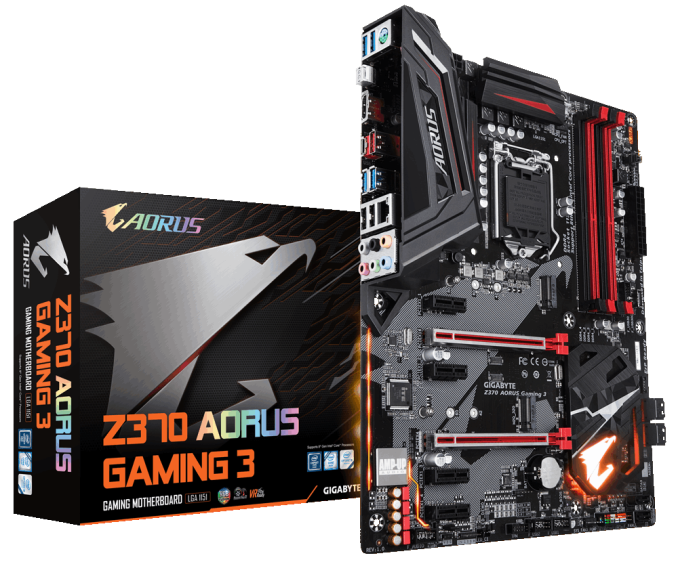Analyzing Z370 for Intel's 8th Generation Coffee Lake: A Quick Look at 50+ Motherboards
by Ian Cutress, Anton Shilov, Joe Shields & Gavin Bonshor on October 20, 2017 2:00 PM ESTGIGABYTE Z370 Gaming 3
The next board is the Z370 AORUS Gaming 3. This board purports to be on the middle of their Gaming series of motherboards and includes RGB Fusion, dual M.2 slots, a Killer E2500 Gaming LAN, the Ultra Durable feature set, and a different color scheme than the other boards in the gaming line.
The Z370 AORUS Gaming 3 uses a black PCB with the AORUS falcon stenciled in through the PCIe area. What is different here compared to some of the other gaming boards is that the reinforced PCIe slots are red instead of black. Instead of all black DIMM slots, two on this board are red; a departure from all black we have seen on the Gaming line previously. The DIMM slots on the Gaming 3 also do not have the strengthened slots. It uses the same chipset heatsink as the Ultra Gaming, and the heatsink is one of two places users will find RGB LEDs on the board. The other location is the audio separation line.
The Gaming 3 uses the platform standard four DIMM slots with speeds up to DDR4-4000 and capacity up to 64GB. The PCIe layout is different on this board compared to what we have looked at previously from GIGABYTE: on this board, there are only two full-length PCIe slots and four PCIe 1x slots. The full-length slots are reinforced (part of their ultra-durable features) and run in an x16/x4 configuration allowing AMD 2-Way Crossfire but not SLI as NVIDIA requires an x8 speed on the slot. That PCIe 3.0 x4 is powered by the chipset, similar to the Z370-P.
For SATA storage, there are six SATA ports, four of which are located on the right side of the board by the PCH, while the other two are found a towards the bottom right-hand corner in a vertical orientation. The two M.2 slots are located just above the top PCIe 1x slot and just above the second full-length PCIe slot. The top slot supports 110mm drives, while the bottom supports up to 80mm.
There are a total of five fan headers on the board. with the CPU and water cooling CPU fan headers by the socket, a system fan by the 8-pin EPS plug, a system fan to the right of the DIMM slots, and the last header is at the bottom of the board. If the lack of RGB LEDs on the board is a turn-off, there are RGBW headers found on the board (one across the bottom, the other by the 24-Pin ATX power connector). Onboard audio is handled by the EMI shielded Realtek ALC1220 codec and like most other gaming boards, uses the Nichicon and WIMA caps. The NIC of choice on this board is the Rivet Networks Killer E2500 and is the only network controller on the board. The Gaming 3 does not include WiFi. Thunderbolt 3 is supported on this board via AIC (Add-In Card).
USB 3.1 (10 Gbps) is handled by an ASMedia 3142 controller and gives us one Type-A and one Type-C adapter both found on the back panel I/O area. From the chipset is another Type-C internal header (5 Gbps), four USB 3.1 (5 Gbps) four ports on the back panel and two more through internal USB headers. There are two USB 2.0 ports on the back panel, and four more through internal USB headers. The remainder of the back panel I/O connectivity consists of a combo PS/2 port, a one-touch overclocking button, an HDMI output for using onboard video, and the audio stack (no SPDIF).
The Gaming 3 finds itself squarely in the middle of the GIGABYTE stack. The mix of features, such as the Killer Gaming NIC, an upgraded audio section, and reinforced slots keep gaming a priority on this board. However, the lack of SLI support will send those with multiple NVIDIA GPUs looking elsewhere.













83 Comments
View All Comments
tommythorn - Monday, October 23, 2017 - link
While that feature page is great, the thunderbolt part is slightly misleading as a few of them supports it via an add-in-card. The page only lists the one that has it built-in. (The lackluster support for TB3 as well as 10 GbE is disappointing).OFelix - Saturday, October 21, 2017 - link
ThanksStochastic - Friday, October 20, 2017 - link
Would you consider putting out some simple Wirecutter-style recommendations? A lot of people (including myself) would like someone else who is better informed to simplify the decision-making process.Ian Cutress - Friday, October 20, 2017 - link
When we get our Z370 reviews underway, we'll start doing some buyers guidesStochastic - Friday, October 20, 2017 - link
Great, thanks!IGTrading - Sunday, October 22, 2017 - link
When do we get a 50+ AMD motherboard article guys ? :)abrowne1993 - Friday, October 20, 2017 - link
Okay but which one looks the coolest?dave_the_nerd - Friday, October 20, 2017 - link
"Whoever thought this was a good idea at Intel needs to be fired."Well... gee... why don't you tell us how you really feel?
DigitalFreak - Friday, October 20, 2017 - link
This whole notch thing makes me wonder if the 8xxx series was originally supposed to work in existing motherboards, but Intel ran into issues at the last minute.KaarlisK - Saturday, October 21, 2017 - link
Honestly, I cannot see the issue. The pins were changed so that nothing bad will happen if you put the wrong CPU in the wrong motherboard.As for the notches, I for one am happy that they were not changed. This means they can reuse the physical design, which lowers validation costs, which makes the CPUs cheaper.